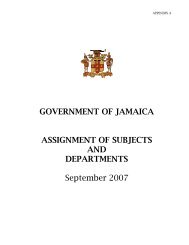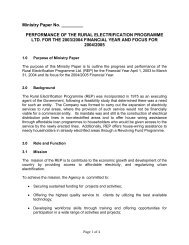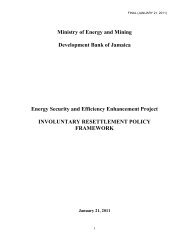Jamaica Biofuels Report - Ministry of Energy
Jamaica Biofuels Report - Ministry of Energy
Jamaica Biofuels Report - Ministry of Energy
You also want an ePaper? Increase the reach of your titles
YUMPU automatically turns print PDFs into web optimized ePapers that Google loves.
cost would be, to future world energy prices. As it stands, the plan devotes one page torenewable resources in Section 6.10, which indicates a potential contribution <strong>of</strong> “>100 MW”from biomass (Expansion Plan, Table 6.10-1). The bids for new capacity, to be submitted inMarch 2011, will provide a clearer indication <strong>of</strong> what new capacity will cost, and biomass-fueledgeneration could save.4.3 Financial Requirements, Financing Regime, and Capital Development OptionsThe cost <strong>of</strong> developing a bi<strong>of</strong>uels industry in <strong>Jamaica</strong> depends on a number <strong>of</strong> parameters, themost important <strong>of</strong> which are:1. Use only existing sugarcane production or develop additional capacity on appropriateland.2. Build one large centralized ethanol processing facility or several small decentralizedones.The first issue is critical, as sugarcane plantations in <strong>Jamaica</strong> have shrunk over the years. At thepresent production level <strong>of</strong> 1.65M tons per year, the potential for ethanol production (usingindustry best practices) is just 36M gallons, even if all cane production was directed to ethanol.This is just 21% <strong>of</strong> current gasoline use, hence limiting the country’s ability to replaceconsiderable amounts <strong>of</strong> imported oil with domestic ethanol.Putting additional land into sugarcane production requires both money and time. Pressurefrom land developers is expected to complicate matters, as it will certainly raise social andpolitical issues even for land owned by the government. Eventually, it becomes a matter <strong>of</strong>policy and economics: a political decision about the country’s sustainable economic growth willhave to be made with agriculture playing a pivotal role. Independent farmers will favorsugarcane plantations only if they can be guaranteed reasonable long-term financial returns fortheir hard work and commitment to the country’s bi<strong>of</strong>uels vision.The second issue – one centralized facility or several smaller ones - is equally important.Economies <strong>of</strong> scale are <strong>of</strong> paramount importance for ethanol production. Even a 36M gallonfacility by ethanol industry standards is considered a small-size facility. If a decision is made toutilize only a portion <strong>of</strong> cane for ethanol production, then the ethanol facility will be evensmaller. Similarly, if instead <strong>of</strong> a centrally located ethanol facility several smaller ones are built,they will suffer from higher operating costs and the total investment required will end up beinghigher for the country. Our advice is to opt for a single ethanol plant either located at thelargest existing sugar mill or built in a central location that minimizes overall logistical costs.Based on information from Brazil for 100M gallon facilities, the cost <strong>of</strong> new (greenfield)sugarcane ethanol plants is approximately $1.50 per annual gallon <strong>of</strong> ethanol capacity if theagricultural infrastructure already exists. The cost jumps to about $3.50 per annual gallon <strong>of</strong>ethanol if the sugarcane plantations need to be developed de novo. In <strong>Jamaica</strong>, based oncurrent cane productivity for a new ethanol plant <strong>of</strong> rather small size (36M gal), a cost <strong>of</strong>35










